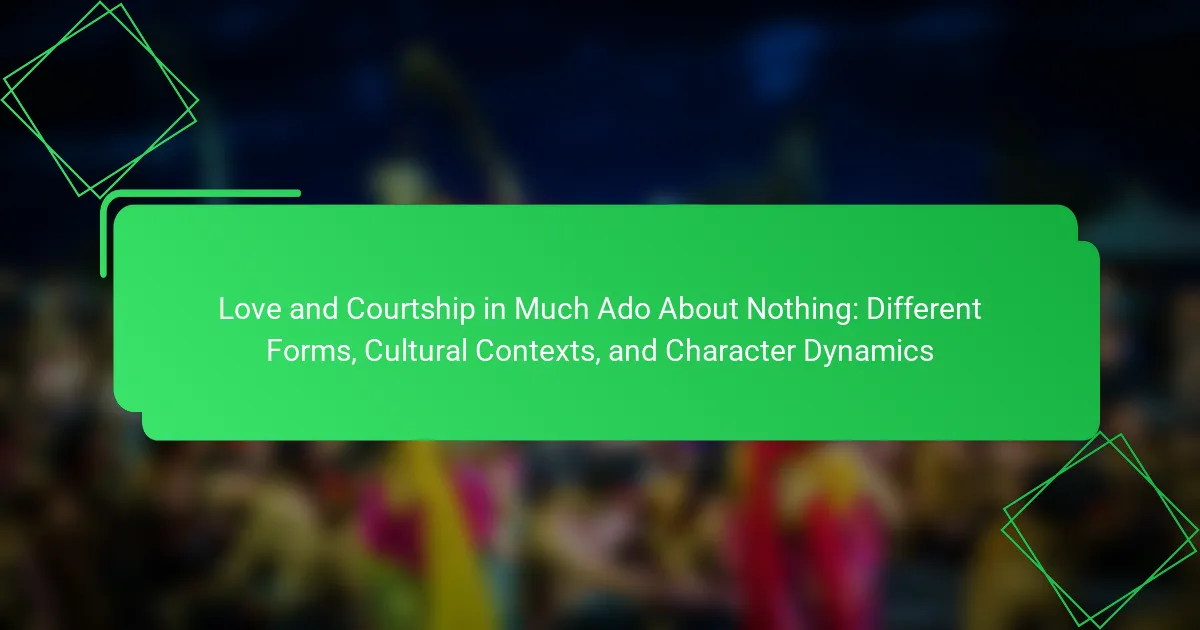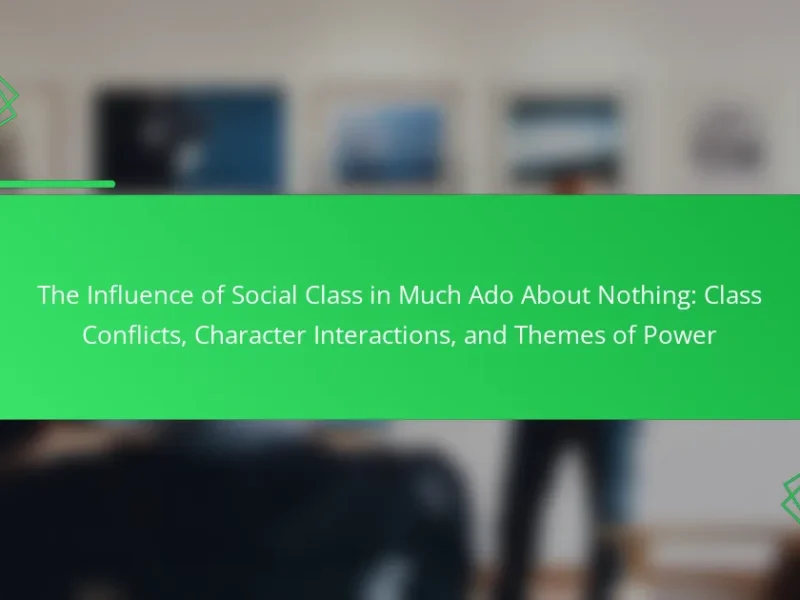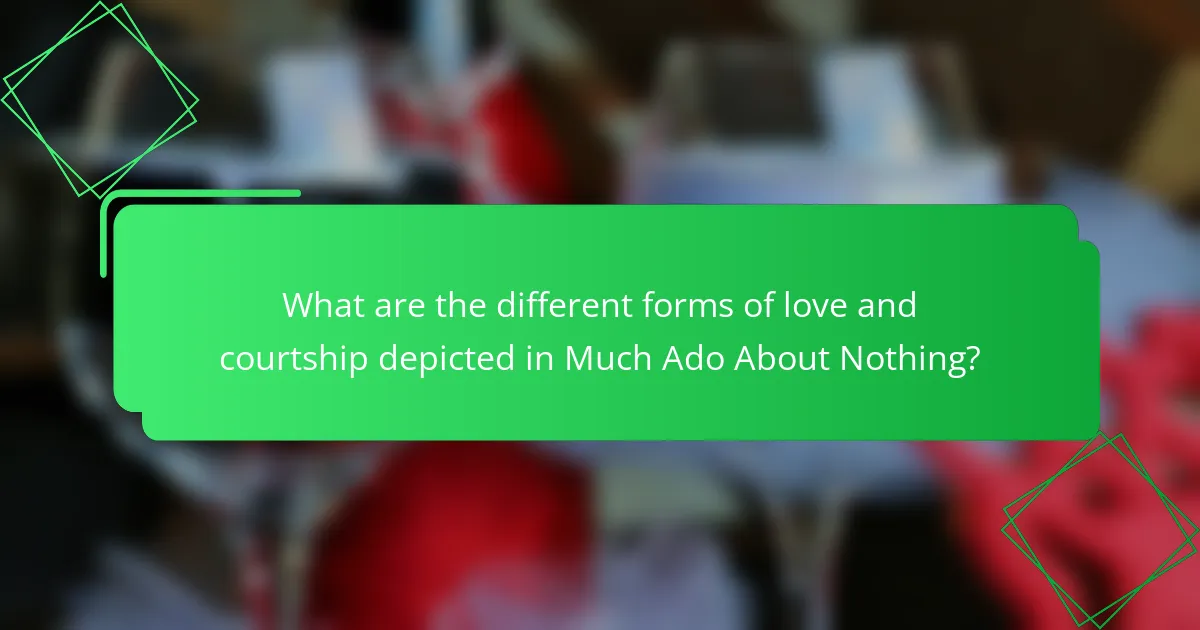
What are the different forms of love and courtship depicted in Much Ado About Nothing?
The different forms of love and courtship depicted in Much Ado About Nothing include romantic love, friendship, and the courtship process itself. Romantic love is primarily illustrated through the relationships of Claudio and Hero, and Benedick and Beatrice. Claudio’s love for Hero is characterized by idealization and public declarations. Benedick and Beatrice’s relationship showcases witty banter and mutual respect. Friendship is represented through the camaraderie between Benedick and his friends. The courtship process involves various schemes and misunderstandings, particularly in the case of Claudio and Hero, where deception plays a crucial role. The play also highlights the social expectations surrounding love and marriage in the Elizabethan era.
How do romantic relationships manifest in the play?
Romantic relationships in “Much Ado About Nothing” manifest through various dynamics and interactions among characters. The relationships are often characterized by wit, misunderstandings, and eventual reconciliation. For example, the courtship between Benedick and Beatrice showcases a battle of wits that evolves into genuine affection. Their banter highlights both the challenges and joys of romantic connection.
Additionally, Claudio and Hero’s relationship represents a more traditional courtship, marked by societal expectations and honor. Their relationship faces turmoil due to deception, illustrating the fragility of love. The play also explores themes of loyalty and betrayal, as seen in the relationship dynamics between Don Pedro, Claudio, and Hero.
Overall, romantic relationships in the play are complex and multifaceted, reflecting both personal desires and societal pressures.
What are the characteristics of romantic love in Much Ado About Nothing?
Romantic love in Much Ado About Nothing is characterized by its complexity and interplay of emotions. It often involves misunderstandings and deceptions, as seen in the relationships between Benedick and Beatrice, and Claudio and Hero. The love between Benedick and Beatrice showcases a witty banter that masks deeper feelings. Their relationship evolves from disdain to mutual affection, highlighting love’s transformative power. Claudio’s love for Hero is initially idealized, but it becomes tainted by jealousy and betrayal. This illustrates the fragility of romantic love under societal pressures. Ultimately, the play presents love as multifaceted, combining joy, pain, and reconciliation.
How do the courtship practices differ among characters?
Courtship practices differ significantly among characters in “Much Ado About Nothing.” For instance, Benedick and Beatrice engage in a witty, combative courtship. Their banter reflects mutual respect and intellectual equality. In contrast, Claudio’s courtship of Hero is traditional and formal. He follows societal expectations, valuing her beauty and status. This leads to misunderstandings and a lack of genuine connection. Additionally, the courtship between Don Pedro and Hero is more transactional, as he acts as a mediator. This dynamic highlights the influence of social hierarchy in romantic pursuits. Each character’s approach reveals their values and societal roles.
What role does friendship play in the context of love and courtship?
Friendship serves as a foundational element in love and courtship. It fosters trust and emotional intimacy between individuals. In “Much Ado About Nothing,” characters like Beatrice and Benedick exemplify this dynamic. Their witty banter reflects a deep friendship that evolves into romantic love. Studies show that friendships often lead to stronger romantic relationships. For instance, research by Sprecher and Regan (2002) indicates that friendships enhance relationship satisfaction. Thus, friendship is crucial in facilitating love and courtship.
How does the friendship between characters influence romantic outcomes?
Friendship between characters significantly influences romantic outcomes by establishing trust and emotional intimacy. In “Much Ado About Nothing,” the friendship between Beatrice and Benedick fosters a foundation for their eventual romance. Their witty banter and mutual respect create a strong bond. This bond allows them to navigate misunderstandings and conflicts more effectively. Additionally, the support from their friends helps them confront their feelings. For example, the schemes of their friends lead them to realize their love for each other. Friendship provides a safe space for vulnerability, which is crucial for romantic development. Ultimately, the dynamics of friendship shape the characters’ perceptions of love and commitment.
What examples illustrate the interplay between friendship and love?
In “Much Ado About Nothing,” the interplay between friendship and love is illustrated through the relationships of the main characters. Beatrice and Benedick share a strong friendship that evolves into romantic love. Their witty banter reflects their deep understanding of each other. Claudio and Don Pedro demonstrate friendship that transitions into love when Claudio falls for Hero. This shows how camaraderie can lead to romantic feelings. Additionally, the friendship between Hero and Beatrice enhances the love story. Their bond supports Hero during her trials. These examples highlight how friendship serves as a foundation for love in the play.
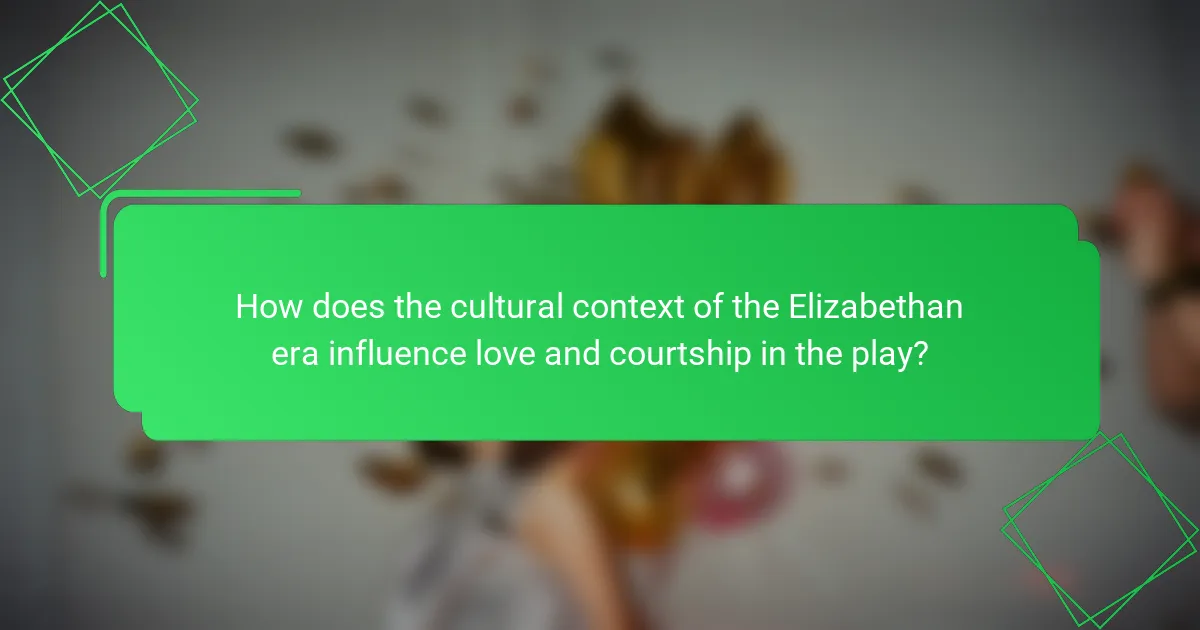
How does the cultural context of the Elizabethan era influence love and courtship in the play?
The cultural context of the Elizabethan era significantly influences love and courtship in the play. During this period, societal norms dictated that courtship was often formal and structured. Arranged marriages were common, prioritizing family alliances over personal affection. Courtship rituals included public displays of affection and formal interactions, reflecting social status. Gender roles were strictly defined, with men taking the lead in courtship. Women were expected to exhibit modesty and virtue, enhancing their desirability. The play reflects these dynamics through characters’ interactions and societal expectations. For example, the character of Hero embodies the ideal of feminine virtue, while Beatrice challenges traditional roles, showcasing the tension within these cultural norms.
What societal norms regarding courtship are reflected in Much Ado About Nothing?
Societal norms regarding courtship in Much Ado About Nothing emphasize honor, reputation, and social status. Characters often engage in matchmaking and manipulation to secure advantageous marriages. The importance of public perception influences romantic interactions and decisions. For example, Claudio’s hesitation to marry Hero stems from concerns about her perceived fidelity. Additionally, women are often objectified, with their worth tied to their chastity. Courtship rituals involve wit and banter, particularly seen in Beatrice and Benedick’s relationship. These norms reflect the patriarchal structure of the society, where men hold power in romantic pursuits. Overall, the play critiques these societal expectations while showcasing the complexities of love and relationships.
How do these norms shape character interactions?
Norms shape character interactions by establishing expected behaviors and social roles. In “Much Ado About Nothing,” these norms dictate how love and courtship are approached. Characters like Benedick and Beatrice engage in witty banter, reflecting societal expectations of courtship as playful and competitive. Claudio’s pursuit of Hero showcases the norm of male dominance in romantic relationships. Additionally, the expectations of honor and reputation influence interactions, as seen in Claudio’s public shaming of Hero. These dynamics create tension and conflict among characters. The adherence to or deviation from these norms drives the plot and character development throughout the play.
What are the implications of social status on romantic relationships?
Social status significantly influences romantic relationships. Individuals with higher social status often have greater access to desirable partners. They may experience increased admiration and attraction from potential mates. Conversely, those with lower social status may face challenges in securing romantic connections. Research indicates that social hierarchy affects relationship dynamics and partner selection. For example, studies show that people prioritize status when choosing long-term partners. In many cultures, social status can dictate acceptable matches and influence familial approval. Thus, social status shapes the landscape of romantic relationships in profound ways.
How are gender roles portrayed in love and courtship within the play?
Gender roles in love and courtship within “Much Ado About Nothing” are depicted as traditional and often rigid. Men are portrayed as assertive, taking the lead in courtship. They pursue women actively, as seen with Benedick and Claudio. Women, in contrast, are often positioned as passive recipients of male affection. They are expected to be demure and modest, exemplified by Hero’s character. Additionally, the play highlights the societal pressures on women to conform to ideals of purity and obedience. Beatrice, however, challenges these norms with her wit and independence. This contrast illustrates a spectrum of gender roles, from traditional to progressive. Overall, the play critiques and reflects the complexities of gender dynamics in its portrayal of love and courtship.
What expectations are placed on male characters during courtship?
Male characters during courtship are expected to display confidence and assertiveness. They are often tasked with initiating romantic advances. This includes making the first move in expressing interest. Additionally, they are expected to demonstrate emotional strength and stability. Male characters should also provide protection and support to their romantic interests. Financial stability is often a consideration, as males are expected to contribute materially. Social status and reputation play a significant role in their courtship strategies. These expectations reflect cultural norms prevalent during the time of “Much Ado About Nothing.”
How do female characters navigate societal expectations in their romantic pursuits?
Female characters navigate societal expectations in their romantic pursuits through various strategies. They often challenge traditional roles and assert their independence. For example, Beatrice employs wit and humor to defy societal norms. She expresses her views on love openly, contrasting with the expected submissive behavior. Hero, on the other hand, embodies the ideal woman but also finds ways to assert her agency within constraints. Both characters reflect the tension between societal expectations and personal desires. This dynamic illustrates the complexities of love and courtship in the play. Their navigation of these expectations ultimately shapes their romantic outcomes.
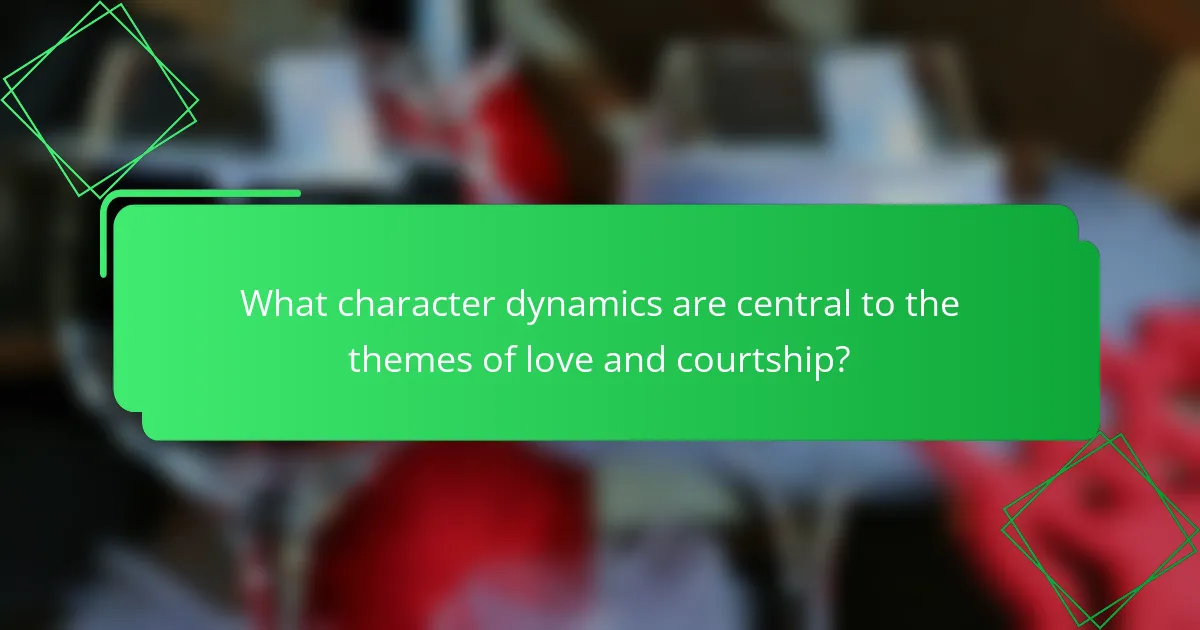
What character dynamics are central to the themes of love and courtship?
Central character dynamics in love and courtship include attraction, conflict, and resolution. Attraction drives characters towards each other, often depicted through witty banter or romantic gestures. Conflict arises from misunderstandings, societal pressures, or personal insecurities. These obstacles test relationships, creating tension that needs resolution. Resolution often leads to reconciliation or deeper understanding, reinforcing the theme of love’s triumph over adversity. In Much Ado About Nothing, Benedick and Beatrice exemplify this dynamic through their initial conflict and eventual union. Their relationship evolves from playful antagonism to mutual affection, highlighting the complexities of love and courtship.
How do misunderstandings impact relationships in Much Ado About Nothing?
Misunderstandings significantly impact relationships in Much Ado About Nothing. They create conflict, mistrust, and emotional turmoil among characters. For instance, Claudio misinterprets Don John’s deception, believing that Hero is unfaithful. This misunderstanding leads to public shaming and the temporary dissolution of Claudio and Hero’s engagement. Similarly, Beatrice and Benedick’s relationship is complicated by miscommunication and eavesdropping. Their initial misunderstandings prevent them from expressing their true feelings for each other. Ultimately, these misinterpretations serve as catalysts for character development and resolution. The play illustrates how misunderstandings can distort perceptions and influence romantic dynamics.
What specific instances of misunderstanding lead to conflict or resolution?
Misunderstandings in “Much Ado About Nothing” often lead to conflict or resolution. One instance is Claudio’s misinterpretation of Don John’s deception regarding Hero’s fidelity. This misunderstanding results in public humiliation for Hero at their wedding. Another example is Beatrice and Benedick’s initial miscommunication about their feelings, which ultimately leads to their reconciliation and union. Misunderstandings related to mistaken identities, such as when Hero is falsely accused, create significant conflict but also pave the way for eventual resolution through truth and reconciliation. These instances illustrate how misunderstandings can catalyze both conflict and resolution in the narrative.
How do these misunderstandings contribute to character development?
Misunderstandings in “Much Ado About Nothing” significantly contribute to character development. They create conflict that reveals true personalities. Characters are often faced with false information, leading to emotional responses. For instance, Claudio’s misinterpretation of Hero’s fidelity shapes his actions and attitudes. This misunderstanding drives the plot and influences his character arc. Similarly, Beatrice and Benedick’s witty banter stems from misunderstandings, showcasing their evolving relationship. These dynamics highlight themes of deception and trust. Ultimately, misunderstandings serve as catalysts for growth and change among characters. They deepen the narrative and enrich character interactions.
What is the significance of deception in love and courtship in the play?
Deception plays a crucial role in love and courtship in the play. It drives the plot and reveals character dynamics. Characters use deception to manipulate emotions and relationships. For example, Claudio is deceived into rejecting Hero based on false information. This deception highlights themes of trust and honor. Additionally, Beatrice and Benedick’s relationship evolves through playful deception. Their friends orchestrate misunderstandings to bring them together. Overall, deception serves as a tool for both conflict and resolution in romantic relationships.
How do characters use deception to influence romantic outcomes?
Characters use deception to manipulate perceptions and outcomes in romantic relationships. In “Much Ado About Nothing,” deception is a primary tool for characters like Don John and Benedick. Don John deceives Claudio by falsely claiming that Hero has been unfaithful. This manipulation leads to a public shaming that jeopardizes Hero’s relationship with Claudio. Benedick, influenced by his friends, is deceived into believing that Beatrice loves him. This deception ultimately leads to Benedick’s romantic pursuit of Beatrice. The use of deception highlights themes of trust and misunderstanding in love. These strategies showcase how characters navigate societal expectations and personal desires.
What moral lessons can be drawn from the use of deception in relationships?
Deception in relationships often teaches the importance of honesty and trust. When individuals deceive, they can harm the bond between partners. This can lead to feelings of betrayal and insecurity. Studies show that trust is foundational for lasting relationships. For instance, a survey by the American Psychological Association indicates that 70% of respondents value honesty over other traits. Moreover, deception can backfire, causing more problems than it solves. This illustrates that while deception may seem beneficial in the short term, it often results in long-term consequences. Ultimately, these lessons highlight the need for transparency and integrity in relationships.
What lessons about love and courtship can contemporary audiences learn from Much Ado About Nothing?
Contemporary audiences can learn that love often involves misunderstandings and miscommunication in Much Ado About Nothing. The play illustrates how assumptions can lead to conflict, as seen in the relationship between Claudio and Hero. Their love is tested by false accusations, highlighting the importance of trust and open dialogue. Additionally, the dynamic between Beatrice and Benedick shows that love can flourish through wit and banter. Their relationship emphasizes the value of mutual respect and friendship in courtship. Overall, the play teaches that love requires effort, honesty, and the ability to overcome obstacles.
How can modern relationships benefit from understanding the dynamics presented in the play?
Modern relationships can benefit from understanding the dynamics presented in “Much Ado About Nothing.” The play illustrates various forms of love, including romantic, platonic, and familial. These diverse representations can help individuals recognize the multifaceted nature of their own relationships.
Understanding conflict resolution is another key benefit. The characters navigate misunderstandings and reconciliations, providing insight into effective communication strategies. This can enhance conflict management in contemporary partnerships.
Additionally, the play emphasizes the importance of trust and loyalty. Observing how these themes unfold can encourage individuals to prioritize these qualities in their own relationships.
Ultimately, analyzing character interactions fosters empathy and awareness. This can lead to healthier dynamics and stronger emotional connections in modern partnerships.
What timeless themes in love and courtship remain relevant today?
Timeless themes in love and courtship that remain relevant today include the importance of communication, trust, and societal expectations. Communication fosters understanding and connection between partners. Trust forms the foundation of any successful relationship. Societal expectations influence how love is expressed and perceived. Historical literature, including Shakespeare’s “Much Ado About Nothing,” illustrates these themes. Characters navigate misunderstandings and societal pressures, reflecting ongoing challenges in modern relationships. Studies show that effective communication and trust are critical for relationship satisfaction. These themes continue to resonate across cultures and eras, making them timeless.
The main entity of the article is “Love and Courtship in Much Ado About Nothing.” The article explores various forms of love and courtship depicted in Shakespeare’s play, including romantic love, friendship, and societal influences. It examines the dynamics of relationships among characters such as Benedick, Beatrice, Claudio, and Hero, highlighting the impact of misunderstandings and deception on romantic outcomes. Additionally, the article discusses the cultural context of the Elizabethan era, the influence of gender roles, and the significance of trust and communication in relationships, drawing lessons relevant to contemporary audiences.
